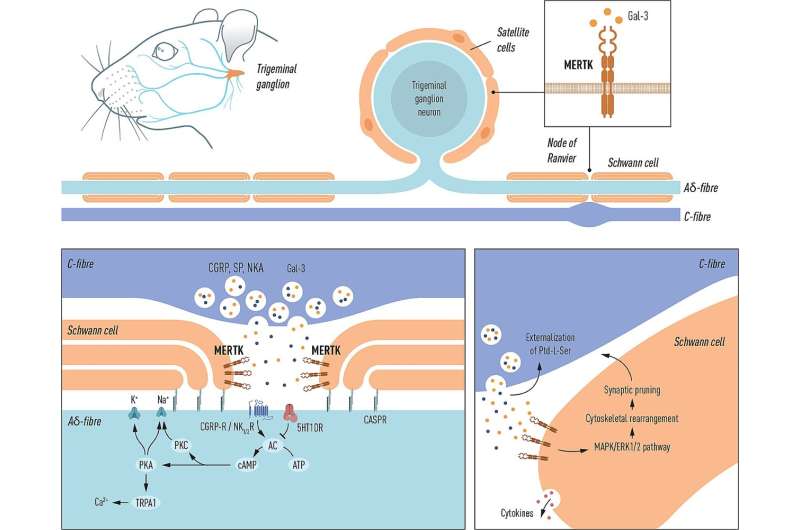This article has been reviewed according to Science X's editorial process and policies. Editors have highlighted the following attributes while ensuring the content's credibility:
fact-checked
trusted source
proofread
Potential future target for treating primary headache disorders identified

Researchers at Karolinska Institutet have identified an interesting potential future therapeutic target in primary headache disorders. They have found increased amounts of a gene associated with cluster headache, MERTK, and its ligand Gal-3, in tissue from cluster headache patients. Their study is published in the Journal of Headache and Pain.
"The trigeminal ganglion is involved in pain signaling during headache attacks and we have been able to show that both MERTK and Gal-3 are localized in this area in tissue from rats," says Andrea Carmine Belin, Principal researcher at the Center for Cluster Headache, the Department of Neuroscience, and last author of the study.
Increased levels of MERTK and Gal-3
A genome wide association study (GWAS) screens genetic markers across the entire genome and compares the frequency between patients and controls to identify genomic regions and candidate genes linked to disease.
"We have made the first characterization of one of the genes most strongly associated with cluster headache in GWAS, the receptor MERTK, using our biobank consisting of biological tissue from cluster headache patients and controls, as well as clinical data," says Caroline Ran, research specialist at the same department, and shared first author of the study.
The researchers were able to show increased levels of MERTK and a ligand that binds to MERTK, Gal-3, in blood samples from cluster headache patients compared to controls.
"The trigeminal ganglion is involved in pain signaling in headache attacks and we have also been able to localize both MERTK and Gal-3 in this area in rat tissue," says Felicia Jennysdotter Olofsgård, Ph.D. student in Carmine Belin's research group and co-author of the study.
A potential cure
These results are important since cluster headache is a severe primary headache disorder where the effectiveness of available treatment is insufficient and produces many side effects. Additionally, there is no cure. No drug has been developed specifically for cluster headache, despite one in one thousand being affected.
"Recently, we and research groups within the International Consortium for Cluster Headache Genetics network have identified a few key regions in our genome strongly linked to an increased risk of developing cluster headaches using GWAS. Genes in these regions could potentially represent future drug targets and we have begun to characterize one of the top candidates, MERTK, in patient and control tissue," says Carmine Belin.
For the human studies, biological tissue from patients with a validated cluster headache diagnosis and neurologically healthy controls were collected.
As the researchers currently did not have access to human nervous tissue, they used rat tissue for studies of the trigeminal ganglion. For the animal studies, the rat trigeminal ganglion was dissected, and they studied MERKT, its ligands as well as receptors and ligands that are well known to be active in this tissue using immunohistochemistry.
Jacob Edvinsson and Lars Edvinsson, both at Lund University, took part in the study.
Next steps
Primarily, the team plans to characterize MERTK and its ligands in other cell and tissue types from patients and controls and study how the activity is affected by immunological reactions in the trigeminal ganglion, as MERTK has an important role in neuroinflammation.
"We also want to examine MERTK in tissue from patients with headache diagnoses other than cluster headache to find out whether MERTK is affected specifically in cluster headache or is generally involved in other primary headaches such as migraine," says Carmine Belin.
Cluster headache and migraines have some similar characteristics in terms of symptoms and are to some extent treated with the same type of medication.
More information: Jacob C. A. Edvinsson et al, MERTK in the rat trigeminal system: a potential novel target for cluster headache?, The Journal of Headache and Pain (2024). DOI: 10.1186/s10194-024-01791-6



















